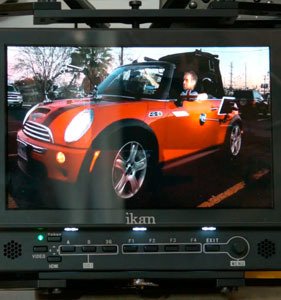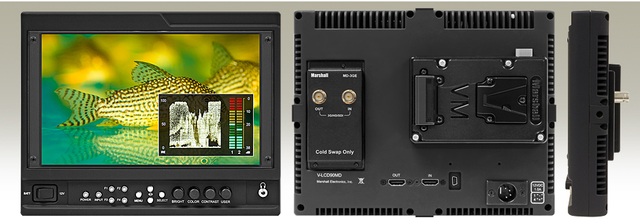With mobile devices reaching insane pixel densities, like the HTC One with its 4.7 inch 1080p display with a whopping 469 ppi (pixels per inch), it makes me long for similar pixel densities on production monitors. The monitor I’m currently using on my rig is the Marshall V-LCD90MD. It’s a 9″ 1280 x 768 panel that clocks in at 168 ppi. Compared to the tightly packed pixels on most high end mobile devices today, my Marshall monitor pales in comparison. Greater pixel density equals better clarity as it becomes more and more difficult for the human eye to be able to see the individual pixels. This is why Apple came up with the “Retina” branding, because the concept is that the pixel density is greater than what the human eye can perceive. Therefore, instead of seeing pixels, all the consumer sees is super clear imagery that perceptively rivals the definition of real life. So why haven’t any of the currently available video production monitors been able to reach these high pixel densities?
I’m no expert when it comes to the manufacturing of production monitors, but what I do know is that RGB (consumer) panels are very different than YUV (professional) panels. Production monitors are color accurate and display a lot more color information than your typical RGB panel. Video production professionals need to rely on accurate colors in order to properly expose for skin tones and different lighting conditions. While production monitors easily trump consumer displays when it comes to color reproduction, why can’t they compete when it comes to resolution and pixel density? I’m not exactly sure why, but I imagine it has something to do with economies of scale and the difficulties introduced when engineering a panel that is both color accurate AND high resolution.
That is the situation as it stands now. However, the technology is evolving and the game is about to change. At NAB 2013 two products were introduced that will change the way we think about production monitors. First off, there’s the ikan 9″ 1920 x 1200 production monitor scheduled to be released in a few months. This monitor has very similar product dimensions to my Marshal V-LCD90MD. The body is the same form factor and the screen is the same size. However, the resolution and ppi of the ikan are far better. This new ikan 9″ monitor is the first of its kind to offer higher than full HD resolution on a 9″ display with ppi that clocks in at 252. This upcoming ikan monitor makes my Marshall V-LCD90MD with its 168 ppi look pretty weak in comparison. Don’t get me wrong, the Marshall is a great monitor with excellent image quality and great features (at $1,599, it better be!). However, I wish it had more pixels! Now that my Canon 5D mark iii (with the just-released firmware update) can display 1080p video to the output monitor, I want to be able to see those additional pixels. If I had the new ikan monitor, I would be able to see all of the pixels that my camera is capturing, which means that I would be seeing exactly what my camera sees. There would be no guess work when it comes to pulling focus and I wouldn’t have to use pixel to pixel mode or 5x/10x focus assist in order to make sure that I had perfect focus. Additionally, the ikan monitor seems to have many of the same features that make the Marshall V-LCD90MD great. It has all the software functions like scopes, blue gun, false color filter, focus peaking and tons of I/O (including 3G-SDI) and battery options (including V-mount and 4 pin XLR) at a price of $999. All I can say is…take my money! There is no official spec sheet or model name for the monitor yet so I’m not sure if it has pass-thru or a headphone jack. I did notice that it seems to have stereo speakers on the front, so it most likely has a headphone jack around back (hopefully it has audio VU meters as well).
The next pixel dense monitor that caught my attention from NAB 2013 was the Atomos Samurai Blade. It has a 5″ 1280 x 720 display with a whopping 325 ppi. Note: Atomos cites the ppi as 325 but according to my calculations it is 294 ppi. Either way, this is new territory when it comes to displays for professional video production. Not only is the display on the Atomos Samurai Blade super sharp, but it’s actually more than just a monitor; it’s a recorder as well! This thing has a ton of cool features and is also a real steal at $1,295.
These new displays will undoubtedly usher in a new era of high ppi panels as the other monitor manufacturers will be forced to compete in the ppi battle. Competition is never a bad thing because it will result in better monitors to pair with our cameras and their ever increasing capture resolutions. Blackmagic Production Camera 4K, anyone?


